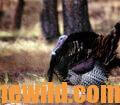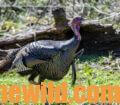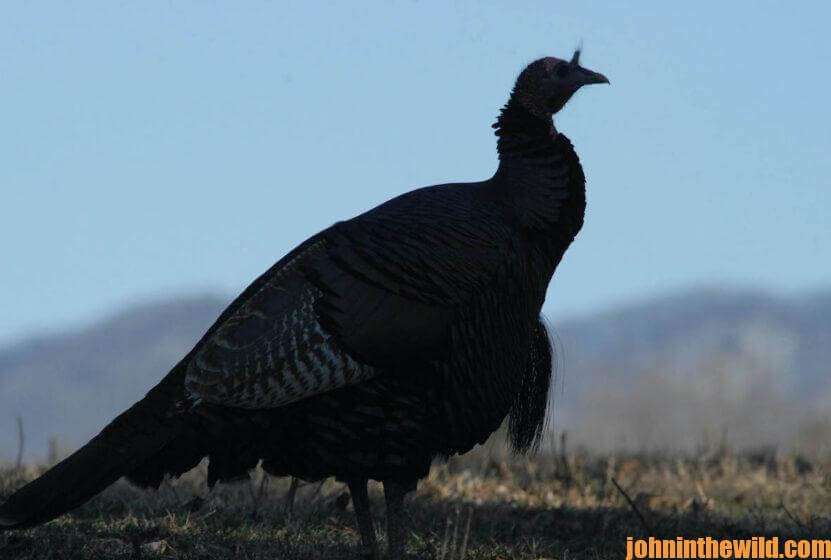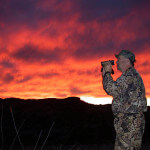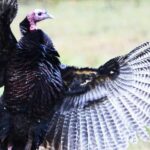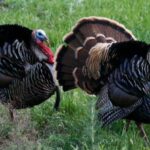Editor’s Note: For fall turkey hunting, calling is the least-important ingredient for success because turkeys rarely gobble in the fall. Therefore, understanding where a turkey wants to be is far-more important than being able to call a bird at most anytime of the year.
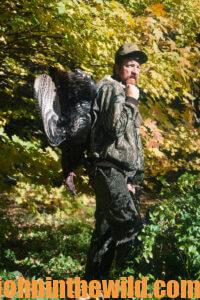 David Hale, one of the owner of Knight & Hale Game Calls (https://www.knightandhale.com/), says that, “I took five gobblers before I ever learned you actually could call them. I hunted turkeys just like I did deer. I’d find the birds in the woods and learn where they wanted to go and what time of day they wanted to feed, strut, water and roost. Then I’d sit still and ambush the birds. If I found a tom strutting, I’d wait until the gobbler had his back to me, and his fan opened. Then I’d crawl in close to the place where he was strutting. In the mountains of Tennessee where I hunted, I learned that turkeys usually would strut on the tops of ridges. After the gobbler strutted away from me, I’d move in close to where he was and bag him when he came back to me. So, learn how to hunt turkeys first, and then how to call. Bagging a bird will be much easier, and you won’t have to rely on the tom’s gobbling to locate a turkey to hunt.”
David Hale, one of the owner of Knight & Hale Game Calls (https://www.knightandhale.com/), says that, “I took five gobblers before I ever learned you actually could call them. I hunted turkeys just like I did deer. I’d find the birds in the woods and learn where they wanted to go and what time of day they wanted to feed, strut, water and roost. Then I’d sit still and ambush the birds. If I found a tom strutting, I’d wait until the gobbler had his back to me, and his fan opened. Then I’d crawl in close to the place where he was strutting. In the mountains of Tennessee where I hunted, I learned that turkeys usually would strut on the tops of ridges. After the gobbler strutted away from me, I’d move in close to where he was and bag him when he came back to me. So, learn how to hunt turkeys first, and then how to call. Bagging a bird will be much easier, and you won’t have to rely on the tom’s gobbling to locate a turkey to hunt.”
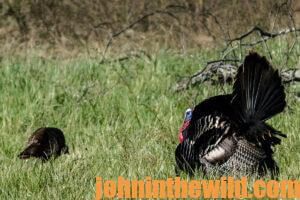 However, just because turkeys aren’t gobbling in the mornings when most hunters prefer to hunt them doesn’t mean the turkeys won’t gobble during the day. Sometimes when you face quiet woods in the mornings, you still can crank-up a gobbler in the middle of the day or in the late afternoon. Also remember that tight-lipped gobblers only may be just in the area you are. Turkeys in another region may be gobbling at another time of the day.
However, just because turkeys aren’t gobbling in the mornings when most hunters prefer to hunt them doesn’t mean the turkeys won’t gobble during the day. Sometimes when you face quiet woods in the mornings, you still can crank-up a gobbler in the middle of the day or in the late afternoon. Also remember that tight-lipped gobblers only may be just in the area you are. Turkeys in another region may be gobbling at another time of the day.
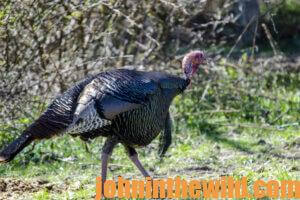 Most turkey hunters realize that when turkeys aren’t gobbling in the morning, you either can hoot like an owl or use a crow call or a hawk call to attempt to make a turkey shock gobble. But on some dreary, overcast, cold mornings, I’m convinced that if a stick of dynamite was set off between the turkey’s legs, the bird might groan but definitely wouldn’t gobble. Their beaks seem to be glued shut at times. When you’re faced with having to hunt these tight-beaked gobblers, you only may be able to rely on your woodsmanship to find a turkey to try to call.
Most turkey hunters realize that when turkeys aren’t gobbling in the morning, you either can hoot like an owl or use a crow call or a hawk call to attempt to make a turkey shock gobble. But on some dreary, overcast, cold mornings, I’m convinced that if a stick of dynamite was set off between the turkey’s legs, the bird might groan but definitely wouldn’t gobble. Their beaks seem to be glued shut at times. When you’re faced with having to hunt these tight-beaked gobblers, you only may be able to rely on your woodsmanship to find a turkey to try to call.
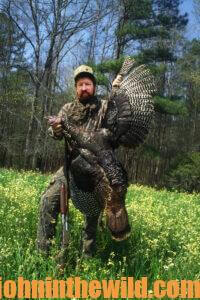 Few rules in turkey hunting are written in concrete except one – the hunter who hunts the hardest and the longest using good techniques consistently will bag more toms than the hunter who only hunts a few hours in the morning at the first of the season. Each day you hunt turkeys provides opportunities to learn more about the birds you hunt. Even if you live in a state where turkey hunting is not permitted past 12:00 noon, if you leave your gun at your car and return to walk in the woods the rest of the afternoon, you’ll learn tons of information about the turkeys you’ll be hunting the following morning. Then you can bag a lockjawed tom whether he gobbles or not.
Few rules in turkey hunting are written in concrete except one – the hunter who hunts the hardest and the longest using good techniques consistently will bag more toms than the hunter who only hunts a few hours in the morning at the first of the season. Each day you hunt turkeys provides opportunities to learn more about the birds you hunt. Even if you live in a state where turkey hunting is not permitted past 12:00 noon, if you leave your gun at your car and return to walk in the woods the rest of the afternoon, you’ll learn tons of information about the turkeys you’ll be hunting the following morning. Then you can bag a lockjawed tom whether he gobbles or not.
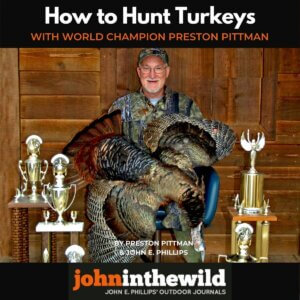 To learn more about hunting turkeys successfully, visit John E. Phillips’ Amazon book page at https://www.amazon.com/John-E.-Phillips/e/B001HP7K6O. For even more information from one of the top turkey hunters and callers, go to https://www.amazon.com/gp/product/B00CFP9V2Q/ref=dbs_a_def_rwt_hsch_vapi_taft_p1_i2 to see the book, “How to Hunt Turkeys with World Champion Preston Pittman,” available in Kindle, print and Audible. You may have to copy and paste this link into your browser. (When you click on the book, notice on the left where Amazon says you can read and hear 10% of the book for free). On the right side of the page and below the offer for a free Audible trial, you can click on Buy the Audible book. You also can order “The 10 Sins of Turkey Hunting with Preston Pittman,” available in Kindle at https://www.amazon.com/gp/product/B00D7NQFS8/ref=dbs_a_def_rwt_bibl_vppi_i10
To learn more about hunting turkeys successfully, visit John E. Phillips’ Amazon book page at https://www.amazon.com/John-E.-Phillips/e/B001HP7K6O. For even more information from one of the top turkey hunters and callers, go to https://www.amazon.com/gp/product/B00CFP9V2Q/ref=dbs_a_def_rwt_hsch_vapi_taft_p1_i2 to see the book, “How to Hunt Turkeys with World Champion Preston Pittman,” available in Kindle, print and Audible. You may have to copy and paste this link into your browser. (When you click on the book, notice on the left where Amazon says you can read and hear 10% of the book for free). On the right side of the page and below the offer for a free Audible trial, you can click on Buy the Audible book. You also can order “The 10 Sins of Turkey Hunting with Preston Pittman,” available in Kindle at https://www.amazon.com/gp/product/B00D7NQFS8/ref=dbs_a_def_rwt_bibl_vppi_i10
 Tomorrow: Learn How Top Turkey Hunters Take Turkeys
Tomorrow: Learn How Top Turkey Hunters Take Turkeys

